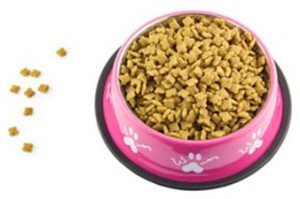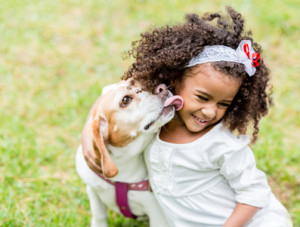Food Allergens and Pets
Written by Michael Pistiner MD, MMSc
Pet Food and Food Allergens 
Some pet foods and treats can contain food allergens. Common ingredients in these meals and treats are dairy, wheat, and soy. Also look for peanuts, fish, shellfish, egg and all potential allergens. The ingredients used will vary depending on the animal being fed (e.g. dogs, cats, rodents, birds, fish, reptiles, etc.). Also, keep in mind that labeling can be a bit tricky as FALCPA (Food Allergen Labeling and Consumer Protection Act) does not apply to pet food. If looking for specific food allergens and there is any question after reading the label then call the manufacturer to ask. When thinking about allergens in pet food, consider ways that your child could come in contact with the pet food and food allergens.
Food Allergens and Saliva 
Food allergens can be transferred via saliva. There have been reports of people with food allergies experiencing symptoms after kissing a person who has eaten one of their food allergens. Maloney and colleagues conducted a study, Peanut allergen exposure through saliva: Assessment and interventions to reduce exposure, that demonstrated that soon after eating peanut, salivary levels of peanut protein were high enough to cause a reaction in some. They looked at different methods to try to reduce levels , like brushing teeth and using mouthwash, and found that they didn’t completely get rid of the peanut allergen. The only method that they found effective was to eat a peanut-free meal several hours after. Knowing that food allergens can be transferred this way can be helpful when considering how to deal with pet licking and kissing in certain circumstances.
She ate what?!Food allergens and your child’s developmental capabilities
 Did you know that kids between 1 and 2 years old put their hands or objects in their mouths up to 80 times an hour (ages 2-5 years were up to 40 times an hour: see study)? For toddlers and kids who are still putting objects in their mouths and possibly eating things that they find on the floor, direct ingestion of the pet food (food allergens) will need to be prevented. Think about where you place your pet’s food bowls, knowing that anything within reach of little hands can easily wind up in your child’s mouth.
Did you know that kids between 1 and 2 years old put their hands or objects in their mouths up to 80 times an hour (ages 2-5 years were up to 40 times an hour: see study)? For toddlers and kids who are still putting objects in their mouths and possibly eating things that they find on the floor, direct ingestion of the pet food (food allergens) will need to be prevented. Think about where you place your pet’s food bowls, knowing that anything within reach of little hands can easily wind up in your child’s mouth.
Food Allergens and other peoples animals
Our kids will also come in contact with animals in settings typically not under our control (other peoples homes, neighborhood, petting zoos, day care, etc.) Although risk of allergen exposure and ingestion is low, considering these contacts and ways to minimize risk of allergen exposure is helpful. An example is being sure that a child’s hands are cleaned after contact with animal saliva and before hands go in the mouth, eyes, or nose.
Special thanks for review by David Tubman, DVM, Associate Veterinarian.
For more information on cross contact see Living Confidently With Food Allergy Handbook. Please stay in touch and follow us on Facebook and Twitter.